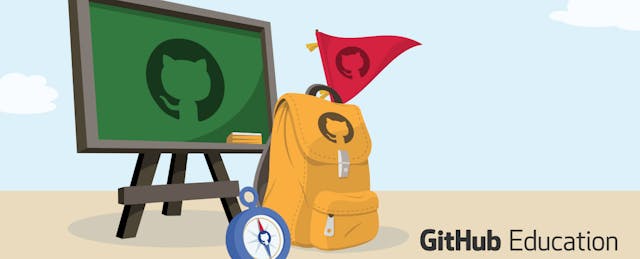What better way to prepare students for coding careers and computer science-related fields than introducing them to the tools that professionals use?
That’s the pitch behind GitHub’s announcement that, starting today, educational institutions will now be able to access—for free—its enterprise and business-level offerings as part of a new GitHub Education package. The company says it’s making these available to any “teaching-focused institution that grants degrees or certificates,” including non-traditional bootcamp-style coding programs.
This new educational package “will give schools the tools for students to succeed, to give teachers a sense of mastery and for the school to be a beacon of technical skills,” claims Vanessa Gennarelli, general manager of GitHub Education in an interview. “Our mission is to help developers learn to code with the real-world tools of industry.”
Used by more than 28 million developers and 1.5 million companies across the world, GitHub is considered the standard when it comes to software development platforms. GitHub is where many companies, including Google, Facebook and Twitter, host their open-source projects.
In a nutshell, GitHub is a collaborative development tool popular among programmers and software companies. One of its key features is a “version control” system that allows multiple people to collaborate on the same projects simultaneously. (Similar to Google Docs, Github will save historical snapshots of a project so that users can always revert to an earlier version.)
Many professional and open-source software projects involve multiple developers who work on source code files. In GitHub, developers can create a copy of project code, make changes and upload the new code back into the main project. (They can also adapt that code for other projects.) GitHub then highlights the changes to help users understand how the new code may impact the project.
GitHub also serves as a portfolio where developers can showcase their individual projects and contributions to others. Increasingly, GitHub has also become a core addition to résumés when programmers look for work. Darrell Silver, co-founder and CEO of Thinkful, an online coding school, said via email that programs like his teach students with the tool “because it's what most employers now expect in all new hires.”
An Expanding Educational Hub
This announcement marks the latest educational outreach from GitHub, which in 2014 unveiled a “Student Developer Pack” that gives credits or free access to third-party developer tools. The following year, it created GitHub Classroom, which allows teachers to distribute and review assignments. More than one million students have taken advantage of these offerings, the company estimates.
According to the company’s tally, more than 18,000 teachers are using GitHub in the classrooms, with GitHub Classroom used in over 10,000 courses. Of the educators who are teaching using the tool, Gennarelli estimates that one-third of them are high school teachers in advanced placement computer science courses, with the rest in higher education.
There’s a long list of technical features in GitHub’s enterprise plan that will now be available for free. (Here’s the company’s features chart.) What’s most important, says Gennarelli, is that school administrators should be able to adopt GitHub “off the shelf” and make it easier for teachers and students to implement the tool.
Among the features available to GitHub Education users are sign-on and access provisioning capabilities, which the company believes will make it easier for school administrators to adopt and implement GitHub across their campuses. Students and schools will also be able to create private repositories so that their work is accessible only to their peers.
For novice programming students, having access to a widely-used, industry-standard tool can give them a sense of how coding projects are done professional settings, says Sheena Vaidyanathan, a middle-school computer science educator in Los Altos School District in California. “One of the biggest wins I see is that you can get students to collaborate on projects. They can each make a change, add a feature and when you find out it’s not working, they can go back and figure it out.”
Still, GitHub may prove a difficult learning curve for coding beginners and elementary-grade classes where introductory lessons tend to focus on individual exercises and projects (like making games), notes Vaidyanathan. In the company’s 2017 educator survey, respondents asked for more teacher training and instruction sheets for students. That spurred GitHub to launch earlier this year a teacher-training program, Campus Advisors, to support instructors in their courses.
Another Score for Microsoft
GitHub, based in San Francisco, has been in the headlines for another reason: Last week it agreed to a $7.5 billion acquisition offer from Microsoft. The deal is expected to be finalized later this year.
In that context, GitHub’s expanded educational offering seems consistent with Microsoft’s recent efforts to “build a developer-friendly reputation,” said Thinkful’s Darrell Silver via email. This announcement could “help GitHub and Microsoft own an industry-standard tool for the next generation of developers,” he adds.
Coupled with its ownership of LinkedIn, there’s a compelling case, made by CNBC, that Microsoft now “owns two of the most influential professional networks” for software developers.
Microsoft has also been active in supporting K-12 computer science education efforts as well. In addition to backing initiatives such as Code.org’s Hour of Code, the company’s philanthropic arm funds TEALS, a program started in 2009 that pairs industry professionals with classroom teachers.
Of the five major technology companies commonly referred to as “GAMFA” (Google, Apple, Microsoft, Facebook and Amazon), Microsoft has become the most acquisitive on the education front. Just this week it bought Flipgrid, a video-discussion platform. Earlier this year it acquired the team behind Chalkup, a classroom management software. Then there’s Minecraft—for which the company paid $2.5 billion—and MinecraftEdu, the team that adapted the game for educational purposes.


